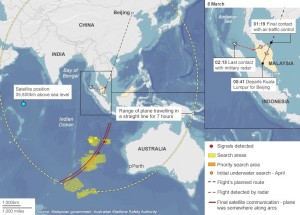There’s still no trace of Malaysian Airlines Flight MH370, which went missing last March, but four vessels are looking for it in the southern Indian Ocean. The search of the new “priority” area — currently 36% complete — began in October and is expected to wrap up in May. This area of roughly 23,000 square miles is more than 600 miles southwest of last spring’s underwater search, but is well inside the plane’s maximum fuel range (see map). Three of the search vessels use towed sonar; the fourth is equipped with an autonomous underwater vehicle. The sonar can penetrate silt that may have accumulated on the wreckage.
Meanwhile, lacking physical wreckage or black boxes, investigators seeking an explanation of the plane’s disappearance have only logical deduction to go on. Several theories — including hijacking or a cargo fire — have been discarded by experts as improbable. Authorities haven’t ruled out a premeditated act. There is circumstantial evidence of this.
First, the plane was deliberately flown off course, making at least three turns that weren’t in its flight plan — by someone who didn’t want to be seen and turned off the transponder. Investigators have eliminated all of the passengers and cabin crew as potential hijackers, so this had to be done by a flight crew member. Based on what has been reported in the media, suspicion is focusing on the captain. It would been easy for him to lock the copilot out of the flight deck with a simple ruse such as sending him for coffee. Then, all he had to do was reprogram the autopilot, a quick and simple procedure.
Although his family denies it, acquaintances confirmed his marriage was troubled and he was having an affair, and both relationships were falling apart. Significantly, alone of the 12 crew members, he hadn’t scheduled any meetings or social activities after the flight, as if he didn’t expect to return. But the FBI has denied a Daily Mail report that a flight track similar to MH370’s was found on his home flight simulator, which would suggest preplanning of the route the plane eventually took.
At this point it’s impossible to say whether MH370 will be found. Australia’s search leader recently said he’s confident it will be found in the “priority” search area. If it is, this story could have significant developments in the next few weeks, as the search reaches its climax.
But I wonder if they’re looking in the right place. The flight track indicates the plane was intentionally diverted from its flight plan, and made several course changes, but the satellite “handshakes” show it eventually flew in a straight line for the last several hours, which strongly suggests the autopilot was flying the plane at the end, with no one steering it. In that case, it would logically have run out of fuel and crashed in an area near the limit of its fuel range, not in the “priority” area which is several hundred miles inside that circle.
For the world it’s a mystery, and our human psychology wants mysteries solved. For the aviation industry, it’s important to know what happened so preventive measures can be taken to keep it from happening again. But one thing everyone agrees on is there needs to be better tracking of airplanes in the air. Government regulators and the industry appear to be moving in that direction, but it takes time.
(Sources: BBC, Wikipedia; map from BBC here. Click on image to enlarge.)